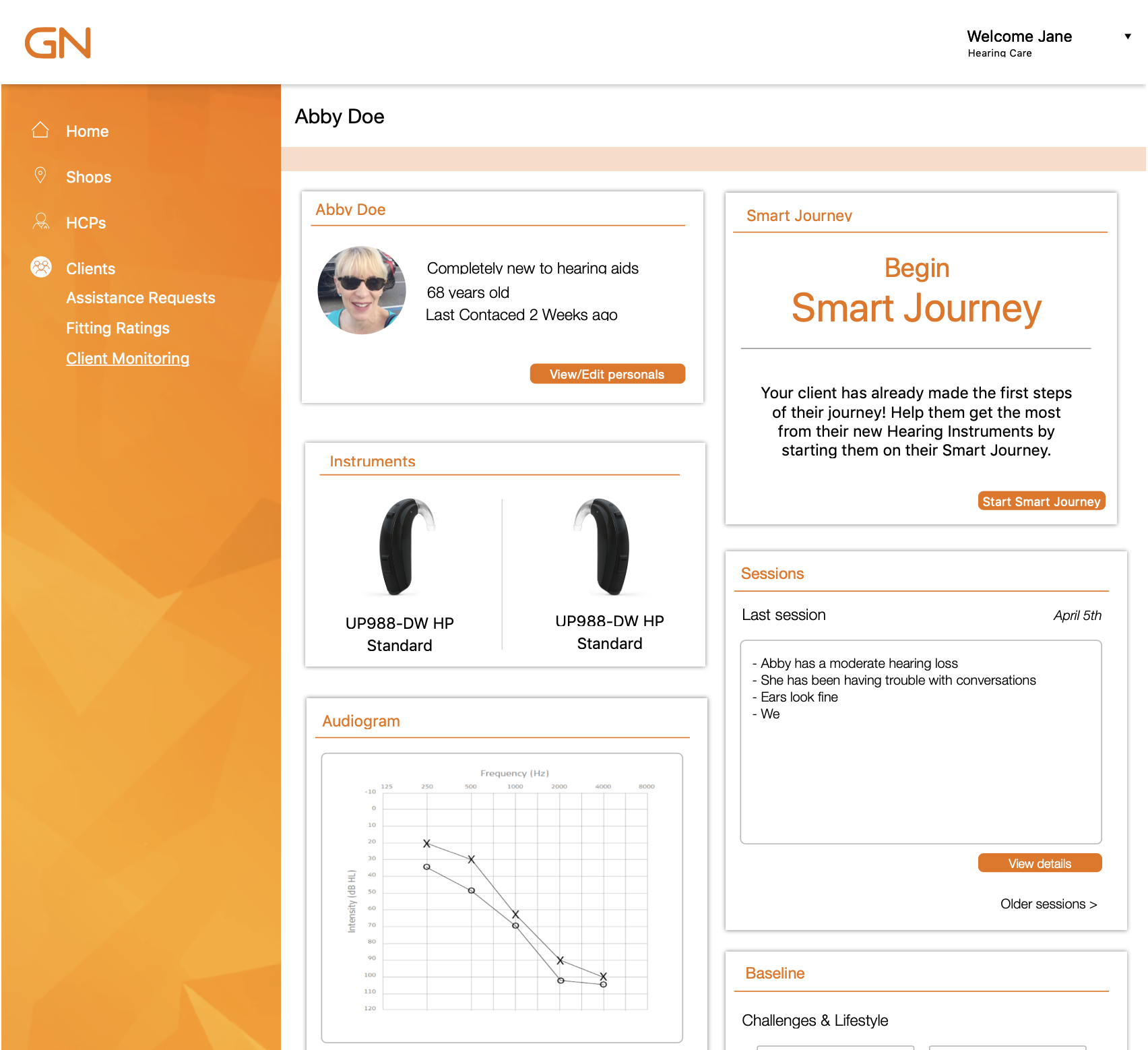Patient onboarding
Platform: Software - Desktop Application, Web, App | Industry: Healthcare (audiology) | My Role: Designer
Project Summary
For both the hearing impaired (patients) and Hearing Care Professionals the process of onboarding a patient to a Hearing Instrument can be difficult. Unlike glasses where the wearer’s vision is immediately, perfectly restored; Hearing Instruments help solve the problem of hearing loss but they are incapable of perfectly reproducing the sound processing of the human ear. The wearer must climatize to the new sound and it’s a process that can take some time. There is a steep learning curve that can cause many emotional ups and downs.
Currently the process of onboarding is completely up to the patient and Hearing Care Professional to navigate on their own. With the success of this onboarding subject to the professionals experience and the patients enthusiasm the results can vary wildly. By providing appropriate tools for a more successful transition we can increase the confidence and happiness of both patients and Hearing Care Professionals while decreasing return rates.
Project Goal
Identify areas during the onboarding process where additional support could be provided to the Patient
Identify areas during the onboarding process where additional support could be provided to the Hearing Care Professional
Recommend tools that could offer support to both the Patient and the Hearing Care Professional
Designing the Right Thing
Step 1: What’s The Problem
In starting this project we felt it was highly important to fully research & understand the process taken by both the Professionals and the Patients in the initial stages of a Hearing Instrument purchase. By understanding the
Through user interviews and focus groups with Patients and Hearing Care Professionals we uncovered the following key findings:
After the second appointment there is a period of time before the follow up appointment where the patient is adjusting to their new hearing instrument and the Hearing Care Professional has no idea if their patient needs any help.
If the patient stops wearing their hearing instrument during this time because they are having difficulties adjusting they may decide to return the instrument all together, missing out on all the hearing health and cognitive health benefits hearing instruments offer.
This onboarding period is emotionally difficult on both professionals and patients due lack of insight and key information.
These conversations led us to create the following items:
The Current Combined User Journey
The Ideal Combined User Journey
A Day in the life of an Audiologist
Step 2: Potential Solutions
When testing with users we had previously found it was difficult to start a dialog with them on a subject containing entirely new functionality. To help spark their creativity we created assets including a mix of LoFi & HiFi Prototypes as well as conceptual use cases with illustrated story boards to be used during initial tests.
Tools used:
Sketch
Adobe Illustrator
Free Hand Illustration
Patient App
Patient Online Dashboard
Professional Online Dashboard
Step 3: Does this solve the Problem for patients
To understand what specific information held the most value with Patients we designed user research where we discussed the following:
LoFi prototypes
Conceptual Use Cases
Desired Functionality
We uncovered that patients found the most value in the following:
Getting instant adjustments to their Hearing Instruments
Allowing their Hearing Care Professional to Monitor their progress
Appointment Follow Ups (notes) that provided more information on the topics discussed with their Hearing Care Professional
A colleague interviewing a test participant.
Step 4: does this solve the problem for Hearing Care Professionals
To better understand the needs of the Hearing Care Professionals we designed user research where we discussed the following:
HiFi imagery paper prototype walk through of potential solution
Conceptual Use Cases
Desired Functionality
After testing we determined the following key findings:
Professionals are nervous about adding another thing to their already busy to do list, but willing to if it increases patient satisfaction
information must be easy to interpret at a glance
It is subjective to each Professional what information is the most valuable based on their previous experience and demands of their clinic so we must all for customization
Step 5: Solution Refinement
Building on the feedback we got from both Patients and Hearing Care Professionals we:
added new use cases & functionality
changed the visual display of information
narrowed project scope
Step 6: Asset Finalization
At this stage we prepared all research documentation in accordance with GDPR from each phase along with adding finishing touches to LoFi & HiFi mockups and prototypes.
Step 7: Presentation of Findings to Portfolio Group & Product Management
The final stage of this project was presentation to the Portfolio Group & Product Management for them to determine how they would like to incorporate it into the roadmap of other future products.
Questions? Feel free to reach out here via the contact page or find me on LinkedIn.
















